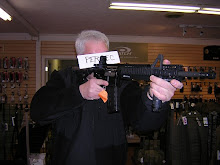However, I lacked a decent interface. I had a Weaver ring on it, but that was too ugly for one as tacticool as me, so I went to work (literally) and picked up a Vltor Scout Mount for it, and while I was at it, I grabbed a shock isolated bezel for it, too. My bro Jimmy Baggadonuts gave me a brand new spare P60 lamp, so I have a spare for this one. Yeah, I have awesome friends.
The thing I found out the next day, though, is that we got the new LED conversion lamps from Surefire in. Dang it. Not what I needed to have happen. Not sure If I'm gonna take the shock iso bezel back or just run this system until the lamps burn out, but I'm kinda leaning towards just running the lamps I have. I could go to the P61L for more output, which is always sexy...until you're clearing a room and find a mirror. Don't ask. I couldn't see very well before. Its worse after.
Oh, well, new parts is new parts. I'm stoked with the simplicity of the engineering of the Vltor mount, and how tight it holds. I'm curious to see how its going to hold up to sustained fire, since I didn't Lock-Tite the screw. The directions didn't say to do that, so I din't. I'll test it as is. At any rate, here are some pics for your viewing enjoyment.



What's all that crap on my front sight post? lol
The reasoning behind the light placement is that its an easy reach for the thumb from the vertical grip. Additionally, if I decide not to run the broom handle, I can still get a forward grip on the fore end...although if I decide to go that way, I may pick up a Viking Tactics mount and run it horizontally off the top of the rail, which would allow a very far forward grip, which I like. As it is now, I still have some rail to lean on a baricade or structure under the FSB. The Daniel Defense 9.5 FSB may just be the perfect rail for guns running fixed front sight blocks.




